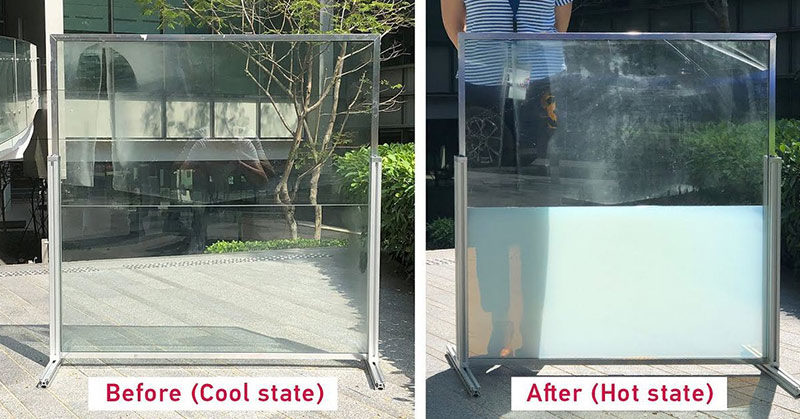Windows and sustainability haven’t always gone hand-in-hand. Scientists at the Nanyang Technological University, Singapore (NTU Singapore) have set out to change that. Their newly-developed liquid window reduces both sun exposure and energy consumption in buildings. (1)
The Liquid Window That Reduces Energy Consumption
According to a 2009 report by the United Nations, 40% of energy usage comes from buildings, and windows are account for half of that energy consumption. (2)
Heat transfer occurs easily through traditional glass windows. This can both cause a building to warm up significantly when the sun is strong, but can also cause buildings to lose heat in the colder months. (1)
The NTU Singapore liquid window reduces both infrared and visible light, something that no other conventional energy-saving low-emissivity windows do. This is a liquid-filled glass window that responds to temperature automatically to regulate how much light can pass through. (1)
The liquid window also has the ability to store heat so it can be released at night time. This as a whole keeps the temperature of the building more constant and requires less work done by a heating and cooling system. The liquid window can decrease up to 45% of heating, ventilation, and air-conditioning usage and cost in buildings. (3)
How the Liquid Window Works
The scientists used a mixture of micro-hydrogel, a stabilizer, and water to tp produce the window (2):
Water has what’s called a high specific heat capacity, meaning that it can absorb a large amount of heat before it gets hot itself. (2)
The mixture of those three turns opaque when heated so that it blocks out sunlight, then returns to a clear state in cooler temperatures. Not only does it allow for more light and heat to pass through in cooler and less sunny conditions, but it also releases stored heat into the building. (2)
This allows the window to shift the timing of when a building uses the most energy to an off-peak time, like a vacant office building at night time. (2)
“Our innovation combines the unique properties of both types of materials – hydrogel and water. By using a hydrogel-based liquid we simplify the fabrication process to pouring the mixture between two glass panels. This gives the window a unique advantage of high uniformity, which means the window can be created in any shape and size.” said the lead author of the study Dr. Long Yi. (2)
Tried and Tested
To prove that the concept works, the research team conducted outdoor tests in various climates (2). These included Singapore (hot climate), Guangzhou (hot climate), and Beijing (cold climate).
The window in Singapore had a temperature of 34 degrees celsius lower than a traditional window during the hottest point of the day. The Beijing window used 11% less energy to maintain the same room temperature. The window fully shifted the “peak” usage of energy for temperature control, which ultimately saves businesses money. (2)
One more benefit of the liquid window? It reduces noise pollution by 15% more than a traditional noise-blocking window. (2)
“Sound-blocking double glazed windows are made with two pieces of glass which are separated by an air gap. Our window is designed similarly, but in place of air, we fill the gap with the hydrogel-based liquid, which increases the sound insulation between the glass panels, thereby offering additional benefit not commonly found in current energy-saving windows.” said study author Wang Shancheng. (2)
Next Steps
The research team is currently looking to collaborate with industry partners to commercialize the liquid window. (2) If they are able to do so, this could completely change the game for sustainable, energy, and cost-saving window technology.
Keep Reading: Student Invented Solar Windows Made from Rotten Vegetables

